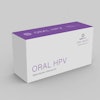
WASHINGTON (Reuters) April 14 - Damage to cells lining the mouth can predict similar damage in the lungs that eventually leads to lung cancer in smokers, U.S. researchers reported on Sunday.
They hope it may be possible to some day swab the mouths of smokers to predict who is developing lung cancer -- saving painful and dangerous biopsies of the lung.
The process may also lead to tests that will predict other cancers, said Dr. Li Mao, an expert in head, neck, and lung cancer at the University of Texas M. D. Anderson Cancer Center in Houston.
"Our study opens the door to enhancing our ability to predict who has higher probability of getting tobacco-related cancers," Mao said in a statement. "Not only lung cancer, but pancreatic, bladder, and head and neck cancers, which also are associated with tobacco use."
Smoking is the leading cause of lung cancer, but only about 10% of smokers ever get it. It causes few symptoms until it is advanced, which means patients are rarely diagnosed or treated until it is too late for a cure.
Mao's team wanted to find a way to monitor patients taking a drug -- the COX-2 inhibitor celecoxib, sold by Pfizer under the brand name Celebrex -- in the hopes of preventing lung cancer.
They looked at two genes known to help prevent the development of cancer -- p16 and FHIT. "There is substantial damage (to the two genes) long before there is cancer," Mao said.
Speaking to a meeting of the American Association for Cancer Research in San Diego, they said they looked for specific damage to these genes in both lung samples and mouth samples from 125 long-time smokers.
"We are talking about just a brushing inside of the cheek to get the same information we would from lung brushings obtained through bronchoscopy," said Dr. Manisha Bhutani, who works with Mao.
The p16 gene was shut down via a process called methylation in the lungs of 23% of the volunteers, while FHIT was affected in 17%. In the mouth, p16 was silenced in 19 percent of the smokers and FHIT in 15% of them.
In 95% of those whose genes were affected, they were affected in both the mouth and the lung, Mao and Bhutani said.
This would make an easier test for prelung cancer than having to access the lung, the researchers said.
This could be useful in monitoring for lung cancer and also looking to see if prevention measures might work.
"This could have strong implications for further lung cancer prevention trials," they wrote in a summary submitted to the conference.
At least one other group is working on a saliva test for breast cancer, one that looks for a mutated version of the HER-2 protein linked to some breast cancers.
Copyright © 2008 Reuters Limited. All rights reserved. Republication or redistribution of Reuters content, including by framing or similar means, is expressly prohibited without the prior written consent of Reuters. Reuters shall not be liable for any errors or delays in the content, or for any actions taken in reliance thereon. Reuters and the Reuters sphere logo are registered trademarks and trademarks of the Reuters group of companies around the world.
















